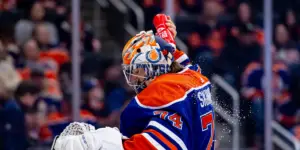
When Mike Grier took over the San Jose Sharks days before the 2022 NHL Draft, he inherited a mess. A team with an aging roster, massive cap issues, and no clear direction for the franchise. Fast forward a season, and Grier’s vision is starting to come into view.
This is a rebuild
Mike Grier embraced what previous GM Doug Wilson would not, a rebuild. Granted, when Doug Wilson was in charge, the Sharks were a perennial playoff team. When they stopped being that, Wilson tried to give his players one last chance to make a run, but that last shot never came. In a span of a year, Mike Grier has traded away an all-time Sharks in Brent Burns, one of their best homegrown talents in Timo Meier, and is on the verge of trading away a freshly minted Norris trophy winner in Erik Karlsson.
While the Sharks are not taking a scorched Earth approach to the rebuild, they realize that the current assets they have must make sense with their timeline. Although the 37-year-old Burns is more machine than man at this point and still is playing good hockey, Burns deserves a chance to win a Stanley Cup. Timo Meier was on his way to producing one of the best offensive seasons in recent Sharks history, but was it wise to add another eight-year contract onto the Sharks cap page? Would Timo still be a 40-goal scorer by the time the Sharks are good again? Maybe? Erik Karlsson put up a historic season last year, but Mike Grier is trying to strike while the iron is hot to get out from his $11.5 million contract that Karlsson is owed over the next four seasons.
Grier has been in the asset-collecting business since he took the job. In the 2022 draft, he traded the 11th pick to the Arizona Coyotes in exchange for picks 26, 34, and 42. Filip Bystedt, who the Sharks took at 26, already looks like a wise choice, and Cam Lund and Mattias Havelid have shown promise over the past year. The Coyotes selected Conor Geekie at 11, and you could argue that Bystedt has been the better pick between the two without factoring in Lund and Havelid.
Protecting the younglings
After trading Brent Burns last offseason (saving $5.28 million), Grier used those cap savings to sign Nico Sturm, Matt Benning, and Oskar Lindblom (combined $5.75 million per season). Many questioned why Grier added these types of players to a Sharks team that was projected not to be competitive last year; it’s to protect the front office and coaching staff from itself. While these signings have worked out to varying degrees (Sturm = great, Benning = good, Lindblom = meh), they have isolated the roster from asking too much of the prospects too soon. William Eklund, the Sharks’ seventh-overall pick in 2021, played eight games. Aside from sliding his contract for another season, it allowed Eklund to play a full season with the San Jose Barracuda and continue to work on rounding out his game every night. This season, Eklund is expected to step into the Sharks lineup as a top-six contributor. While there will still be rookie up and downs, Eklund should be better prepared for the grind of the NHL.
Grier has also decided not to go full scorched Earth approach. Keeping Logan Couture and Tomas Hertl as the team’s top centers allows the Sharks to have good players for the younger players to lean on. While Couture had a great season and Hertl had a below-average season last year, it keeps players like Thomas Bordeleau and Tristen Robins from being called upon too early to play those minutes. It also allows guys like William Eklund and Danil Gushchin to have pivots who can drive play while they still get their feet wet in the NHL. While neither Couture nor Hertl may see the end of their contracts in San Jose, they are important players for the prospects to learn and grow from now on as the next core is established.
Hope you have a big trunk
No group has been turnover more than the defensive pipeline in the last year. Mike Grier has done some work to overhaul this group.
- Henry Thrun (6’2″)
- Valtteri Pulli (6’6″)
- Shakir Mukhamadullin (6’4″)
- Nikita Okhotiuk (6’0″)
- Leon Gawanke (6’1″)
- Mattias Havelid (5’10”)
- Michael Fischer (6’2″)
- Jake Furlong (6’1″)
- Eli Barnett (6’6″)
- Luca Cagnoni (5’9″)
- Eric Pohlkamp (5’11”)
- Axel Landén (6’1″)
While sending out:
- Santeri Hatakka (6’0″)
- Artemi Kniazev (5’10”)
- Ryan Merkley (5’11”)
While size isn’t everything, and at the end of the day, you need good players, Grier wanted more size and length on the blue line that needed a teardown. Cagnoni still represents the short kings out there, but his ceiling as a team’s second or third-best defenseman makes it easy to overlook his lack of size. This, paired with the fact of getting him at 123, is too good of a value.
With the fabled 2020 draft class that had most of its selections under 6’0″, having some bigger defenseman on the ice to help compensate for a smaller forward group is needed. The Sharks still need a potential star defenseman in their pipeline, but the group has a much higher floor than we’ve seen over the past few years, and the path for several of these players to work out isn’t that hard to imagine.
While Mike Grier’s tenure hasn’t been perfect, you can see the plan forming. It’s easy to overreact in the moment when Brent Burns turns into Steven Lorentz, Eetu Mäkiniemi, and a third-rounder (Brandon Svoboda), but then turning Lorentz into Anthony Duclair or getting Quentin Musty from the Timo Meier trade has long-lasting ramifications that aren’t seen in the moment. Yes, it was lucky for Musty to fall to 26, and yes, Grier took advantage of a cap-strapped team in the Florida Panthers, but those little moves are what a rebuilding team has to do. Can Grier continue to work his magic with a reclamation project like Filip Zadina and start to see young players like Eklund and Bordeleau make an NHL impact? That’s what the 2023-24 season is for.
Discover more from Inside The Rink
Subscribe to get the latest posts sent to your email.



